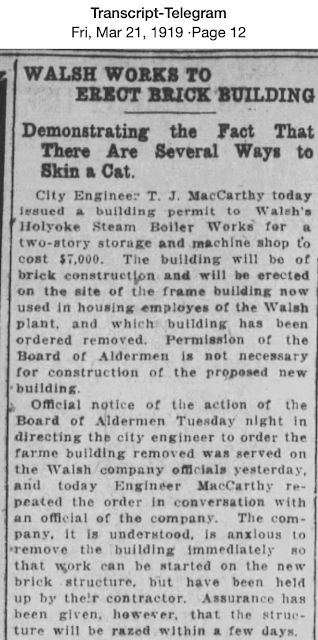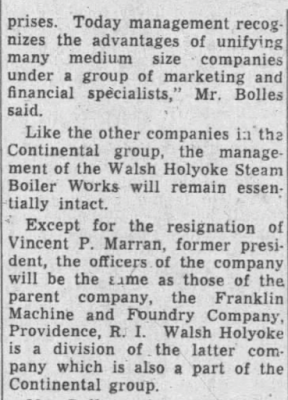When thinking of Holyoke's turn-of-the-20th-century business ventures, several products come to mind. This includes paper and paper products, thread, garments, silk and silk products, machinery, and equipment, to name a few.
Building pontoon boats, ships, bomb casings, snowplows, and locomotive repairs likely would not immediately enter the discussion. This is the story of Walsh's Holyoke Steam Boiler Works, which manufactured these and other water power-related products during its sixty-one years of operation in Holyoke.
Walsh's Holyoke Steam Boiler Works began operations in Holyoke in 1894. The partners in this venture were William J. Walsh and Charles D. Heywood. The plant was located on Mechanic Street behind its business office, constructed about 1918 at 110 Appleton Street.
A 1900 Price & Lee Holyoke City Directory advertisement identified several steel fabrication specialties. These included manufacturing steam boilers, penstocks or floodgates, steel tanks, rotary bleach boilers, iron roofs, standpipes for reservoirs, building and bridge girders, and fire escapes. The business's main product was the steel-fabricated boiler, which employed approximately 100 workers in production.
The expanse of their sales, distribution, and service area spanned the eastern United States and the breadth of Canada from Newfoundland to Vancouver, South America, Latin America, Europe, and Asia.
To provide context to their work, in 1899, the company produced 1,500 feet of penstock using 125 tons of steel for a New Hampshire concern and 450 feet of wider diameter penstock using 100 tons of steel for a Dayton, Ohio, company. The plant was adjacent to the rail line to receive production materials and transport the heavy finished products to customers.
During the 1910s, the company provided steel for the Realty Building alteration at High and Dwight Streets and work at Monson State Hospital.
In 1914, it was awarded a significant contract to provide penstocks as part of a power production plan involving harnessing the Yodkin River in Whitney, South Carolina. It was estimated that 100 carloads of penstock weighing 2,000 tons would be shipped by rail, and 200 workers would be provided with nine months of employment. One of the penstocks would be 7,000 feet long and nine feet in diameter. At the time, manual welding and riveting connected the pieces.
During World War I, the company produced entire ships sent in pieces to shipyards for assembly.
In mid-February 1919, 200 plant boilermakers went on an eight-week strike. During that time, the company erected a wooden building to house workers who would replace the strikers. The building was built without permits, and the city ordered it torn down. After some protests, it was removed, and the city approved the construction of a brick structure.
In the 1920s, the company was awarded contracts to replace the second-level canal bridges on Appleton and Cabot Streets. The Metropolitan Water Commission (MWC) and other water departments also awarded the company contracts for piping.
During the railroad strike in 1922, the entire plant was dedicated to keeping the New England locomotives in mechanical repair to keep the flow of shipping moving. At times, there were 100 locomotives outside the plant.
In 1927, The Walsh's Holyoke Steam Boiler Works, working with A. O. Smith Co., shipped 1,800 carloads of piping to Milwaukee for the Dixie Pipe Line Company.
Also, in 1927, the company secured a contract to provide seven to nine miles of welded pipe for a Daniel O'Connell's Sons project. The project connected a water supply from the Proven Mountain in the Feeding Hills section of Agawam to Springfield to provide water for the Forest Park area and neighboring Longmeadow, MA. The pipes ranged from 36 to 66 inches in diameter, and twin pipes crossed the Connecticut River. This installation job provided workers with one year's work.
The company used the most up-to-date electrical welding machinery from General Electric to facilitate the pipe production. This was the first significant application of the metallic arc welding system, which was automated and did not require human hands or heavy rivets. At the time, it was the largest arc welding machine in operation.
In late 1927, the company sent three large snowplows to Siberia through a Russian dealer. Previously, a snowplow had been shipped to Austria.
The company was incorporated in 1928 with William J. Walsh as president and Charles D. Heywood as treasurer. Mr. Walsh resigned in 1929 due to health reasons and was replaced by Bruce Pirnie, a banker from Springfield.
The company prospered during the Great Depression years and World War II. In 1929, the Walsh company delivered two spiral turbine casings and two turbines to the Montana Power Company of Great Falls, Montana. The water inlet pipe was over 21 feet in diameter, the outlet seven feet, allowing almost 28,000 gallons of water to pass through per second. At the time, it was the third-largest casing ever produced in the country. Each casing weighed 91 tons, the rivets alone four and a half tons.
In the early 1930s, large jobs transporting water followed in Worcester, Watertown, Boston, the Metropolitan District Commission, and the Hampden Brewing Company in Willimansett. The City of Worcester sent representatives to meet with the company's engineers and technicians to observe its methods of manufacturing stainless steel piping, as cast iron was previously commonly used.
In April 1941, the company was awarded a contract to build 500 specially designed U.S. Navy steel pontoons for the war effort. By October, it had built 1,000, and new agreements had been received. The plant worked three shifts, 24 hours a day, to fulfill the contracts.
President Harry Truman's Defense Investigating team called for an examination when a company submitted a fraudulent lower bid after the deadline. The company could not produce pontoon boats.
Other war-related manufacturing kept the business active in the 1940s.
In 1944, Walsh's Holyoke Steam Boiler Works was purchased by the Franklin Machine & Foundry Co. of Providence, Rhode Island. Franklin was a division of Continental Copper and Steel Industries Inc. The firms were not competing; the purchaser felt this was a complementary business.
Also, in 1944, buildings were constructed to house the welding department and to provide storage for the pontoon boats built for the U.S. Navy.
In July 1956, the Walsh plant was shuttered. The reason given by Continental was that it had a plant in Portland, Maine, which could do the same work in a better facility. Interestingly, the Portland, Maine, plant was shut down one year later.
Citations:
Newspapers.com (paid subscription): Citations: Holyoke (Massachusetts) Transcript & Transcript-Telegram; publication dates are shown.
Holyoke Public Library, Holyoke, Massachusetts, City Directories.
History of Massachusetts Industries (Orra L. Stone), Chapter xxvii, p. 593 - Holyoke
(Above)Photo Credit: Lewis Hine, (1936) Holyoke , Massachusetts Scene(Below) First photo: Looking west toward the Appleton Street underpass (from ~ Bowers St.) with the taller B.F. Perkins factory, beyond the underpass. The smaller building in the background is likely at the corner of Main and Appleton Streets.

































































































No comments:
Post a Comment